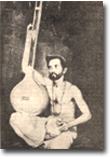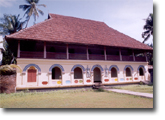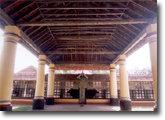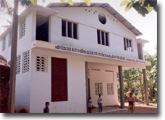Shadkala Govinda Marar

Following is an article on Shadkala Govinda Marar by Sri P. T. Narendra Menon titled “ The Saint who was a Mahanubhavulu”, published in the daily newspaper The Indian Express on December 27, 1992
The Saint who was a Mahanubhavulu
By P.T.Narendra Menon
The ancient temple on the banks of the Muvattupuzha river is still there; its walls grey with the smoke of oil-lamps, and its stone-paved floor worn smoth by the tread of many generations of worshippers. Here was the sopana, the little flight of steps leading o the sanctum-sanctorum, where sat the bedecked figure of Narasimhamoorthy (man-lion), shining in an assortment of flower garlands, and dancing wicks of light.
This was the exact spot where the legendary bard of the village, famed Shatkala Govinda Marar stood and sang his paen to the deity more than one and a half centuries ago. The doves are still there cooing at the turrets, and the handful of worshippers are also there, but the ancient style of singing, sopana, has all but disappeared.

House of Shadkala Govinda Marar’s relatives at Ramamangalam |

Ramamangalam Temple |

Govinda Marar Smarakam |
This sleepy and sequestered village of Ramamangalam saw the birth of Govinda Marar in 1798, who drew forth from no less a saint-singer than Tyagaraja, the immortal pancharatna materpiece ‘Entharo mahanubhavulu’.
Very little is known about his childhood. The present-day Marar families who live in the village, who claim descent from him have only sparse information about their illustrious ancestor. Some enthusiastic people of the locality have organised a ‘Govinda Marar Smarakam’ in a building adjacent to the temple and music and dance classes are conducted there. The Government of Kerala has this year announced yearly grant to it. But the Smarakam has not succeded in acquiring any records on the life of the singer.
The old Marar ladies have heard from their grand-mothers the following: Govinda has a golden voice, with immense range. From his infancy, he was something of an outsider, a loner obsessed with music, spending all his time ceaselessly singing, and playing on the edakka at the temple. An uncle, who had been to Thiruvananthapuram had gifted him a tambura, with which he was greatly entranced. By experimenting he had converted it into a seven-stringed instrument. All the strings, except the mandram were doubled with the result it had two panchamas, two sarinis, two anusarinis, and one mandram. Marar used this tambura all through his life. At 18, he suffered from an acute attack of rheumatism, but he cured it with what we now call music-therapy, by a relentless singing of some kind of music.
In spite of his astonishing musical talents, Govinda Marar was of a restless disposition, his restlessness being the first for attaining some sort of realisation. So, we find him leaving his village at the age of 21, on foot, never to a return, carrying only his tambura and edakka. He sang soulful tyanis and ashtapadis in many temples, sometimes before the deity and often sitting beneath the banyan trees, and eating whatever was brought to him by those who heard his music.
The legends attached to many temples in Kerala say that Marar used to do the Kottippadi Seva (ritual singing of devotional music during the five daily poojas to the accompaniment of edakka) there for a month. The one at Ambalappuzha Krishna Temple recounts that on reaching the sanctum sanctorum, he found the stick of his edakka missing, and he played it with an ezhuthani (writing quill)supplied by a devotee. He sang the whole of the Geet Govind, and had the congregation spellbound by the flow of his music.
We do not know, where else he wandered, but eventually we find him as one of the vidwans of Maharaja Swati Tirunal’s court.
The Maharaja himself was utterly dedicated to music, he was a composer of no mean ability, and his court was studded with a galaxy of musicians including Vadivelu, Palghat Parameswara Bhagavathar, Meruswamy, and Kanniah.
Once Swati Tirunal wanted Marar to sing the Puraneer raga in the evening. This raga is usually rendered only for the early morning pooja. Marar had to comply, and such was the haunting quality of his alapana that the assembled had the illusion of breaking down. The appreciative Maharaja honoured Marar by bedecking his seven-stringed tambura with a vaijayanti (flag of victory).
It is believed that Marar had this flag on his tambura, till he reached Benares in the last years of his short life, where he discarded it, as all pride in his musical prowess had deserted him by that time.
In spite of being soaked in music and art, the palace and its patronage did not satisfy Marar for long, for whom music had a higher aim. While at Thirivananthapuram, he had heard with deep admiration the kritis of Tyagaraja, sung by Kanniah, a direct disciple of the saint. To him Tyagaraja became a holy beacon. One Haripad Ramaswamy Bhagavatar also had learnt those kritis. Marar learnt a few such kritis from him. Soon he was all agog to have darshan of the saint at Tiruvayyaru, and in 1837 he set forth on foot, and reached the house of Tyagaraja on an ekadeshi day.
The daily bhajan session led by Tyagaraja himself was on when the weary wayfarer reached the place.
When the first half of the bhajan session was over, the guest was invited to sing as was the custom. Marar had already been noticed by those assembled due to his glowingly ascetic appearance, and his unusual tambura, with the flag. Being ekadeshi, it was a day dear to Hari, and he chose his favourite Geet Govind song, ‘Chandana charchitha neela kalebara’, in Pantuvarali raga.
Prof.Sambamoorthy reconstructs the memorable scene from information gathered from the palm-leaf biography of the saint written by his direct disciples, Walajapet Venkitramana Bhagavathar and Tanjore Rama Rao, and from the notebook of another direct disciple, Krishnaswami Bhagavathar, thus:
“He (Marar) started singing in the ati ati vilambita kala (first degree of speed). People were wondering why he started at such a dead slow tempo, but they were struck by the precision in duration between count and count. Then he sang the chosen theme in ati vilambita kala (second degree) Vilambita (third degree), Madhyama kala (fourth degree), druta kala (fifth degree) and ati druta kala (sixth degree). As he approached the fifth degree of speed, the entire audience was spellbound, and when he sang in the sixth degree of speed, Tyagaraja himself was taken aback by his laya sampat”. During the performance he was strumming the tambura with his right hand , and playing the ganjira with his left hand, holding the latter instrument in position between the toes of his right leg.
Tyagaraja immediately perceived in Marar a brilliant musician of rare genius. His spiritually evolved soul also recognised him as a mahanubhava (great soul), who like himself was seeking satchidananda, through Sangeetha. To pay tribute to the visitor, Tyagaraja asked his disciplies to sing his scintillating Pancharatna kriti ‘Entharo mahanubhavulu’ . The Walajapet disciples have used the word ‘prasthutimpa’ in Telugu, meaning ‘in order to pour out praise’.
The belief in Kerala is that Tyagaraja composed the kriti extempore in his spontaneous joy on hearing the spiritual and musically fantastic singing of Marar. But the version of the Walajapet disciples would have it that the kriti was already composed, and the disciples had learnt it before the arrival of Marar.
Anyway, the time of the composition of the kriti is immaterial. That Tyagaraja wanted his disciples to praise the strange ministrel by describing him as a mahanubhava, and that too through one of his outstanding kritis was in itself a recognition of not only Marar’s music, but also of his personality.
The latter fell at the feet of Tyagaraja with tears in his eyes, who lovingly asked Marar to stay with him.
The association with Tyagaraja must have strengthened the vein of renunciation in his mind, and bidding adieu to his beloved ideal, Marar started on an indefnite itinerary.
Again he becamee an avadhoota (wandering mendicant in the process of salvation). He finally reached the temple of Panduranga in Pandharpur, near Poona. By this time he must have attained what his restless soul had been seeking from infancy, and he used to sit in the temple and pour out music in a frenzy of ecstasy. He was looked upon as a paramahamsa Govind Das by the people flocking to the temple, a jeevanmuktha. The temple records reveal that he attained samadhi in 1843,while singing.
Thrikkampuram Krishnankutty Marar (b.1936) who is believed to belong to Shadkala Govinda Marar’s family who performs Panchavadyam, Sopanam, Kottipadiseva, Kalamezhuthupattu and an exponent of Kudukkaveena, claims Govinda Marar was uncle to his great grandmother. Krishnan Marar lists five compositions of Govinda Marar
- Ksheerasagara vasa ramadhava – Kedaragoula – Muriyadantha
- Palayamam Parvatheesa – Aanandabhairavi – Aadihalam
- Thunga pinga jada kalapavum – Bhoopalam – Thriputa
- Balachandra vibhushanam – Aarabhi – Aadi
- Lokapalane – Mohanam – Aadi
Krishnakutty Marar also argues that the Swathi composition Narasimha mamava (Aarabhi) is actually Govinda Marar’s. The last line in the charanam “Parama Mangala shobha pankajanabha” could have been “Raama Mangala shobha” which is the mudra for Govinda Marar. (This is unlikely since the previous line is “Paramakripa rasa pari paalethebha” which rhymes with the last line in the second sound, as is the case with other charanas.)

